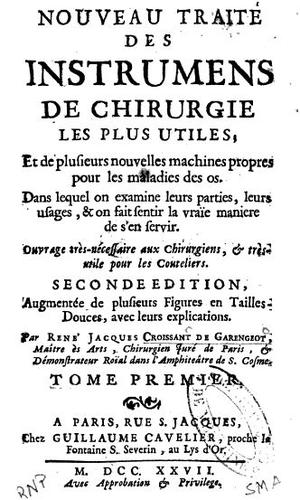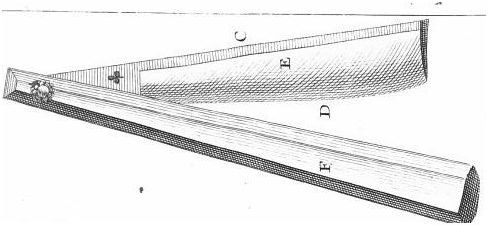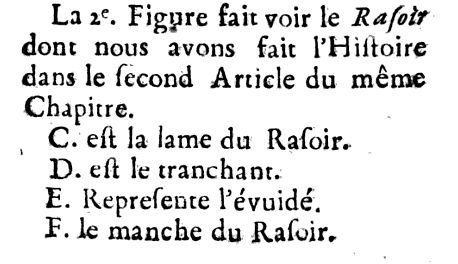Results 1 to 10 of 10
 24Likes
24Likes
Thread: The year is 1727, the razor (Illustrated) is concave/hollowed.
-
10-05-2013, 03:58 AM #1Historically Inquisitive



- Join Date
- Aug 2011
- Location
- Upstate New York
- Posts
- 5,782
- Blog Entries
- 1
Thanked: 4249 The year is 1727, the razor (Illustrated) is concave/hollowed.
The year is 1727, the razor (Illustrated) is concave/hollowed.
In 1727, a french master Surgeon named Rene Jacques Croissant De Garengeot, wrote a book about surgical instrument. The book contains a description, how to use and maintain many different surgical instrument.

A section of the book is devoted to razors. He describe the razor as a knife like blade with a handle that pivots, its use to shave the beard and other area for preparation of surgery. Clearly explains every part of the razor, the edge, the back (spine) and how the delicate edge closes within the handle or scales.
The author explains that the blade relation between the edge and the spine is hollowed slighty with the help of a round grinding stone,
to create a finer edge from heel to toe. Furthermore his claims that the razor with that grinding (hollow) is easier to hone on the stone.
The discussin move to the dimensions of the razor witch is pretty close to what we know today. The materials used for the scales are tortoise shell, horn, and sometimes wood. Always proportioned to the blade usually around 6 inches. A nail used for pins and washer from silver or copper.
Next is honing the razor, and how to hold between the thumb and index finger, flat on the stone and never let the spine off the stone even when flipping the razor.
And finally the illustration of the razor, with its parts description.


C = The razor blade
D = The razor edge
E = The hollowing
F = The scales.
-
The Following 10 Users Say Thank You to Martin103 For This Useful Post:
25609289 (10-05-2013), BobH (10-05-2013), Frankenstein (10-05-2013), Hirlau (10-05-2013), Lemur (10-05-2013), Miner123 (10-30-2013), Neil Miller (10-06-2013), rolodave (10-05-2013), Voidmonster (10-08-2013), Wolfpack34 (10-05-2013)
-
10-05-2013, 06:43 AM #2

Good info as usual but is there any more on how to hold them while shaving?
I hold the tang between my thumb and index finger but it doesn't feel very secure!Hur Svenska stålet biter kom låt oss pröfva på.
-
10-05-2013, 11:33 AM #3Historically Inquisitive



- Join Date
- Aug 2011
- Location
- Upstate New York
- Posts
- 5,782
- Blog Entries
- 1
Thanked: 4249
The grip he describe is the same as grip 1 from this link Different ways to hold a straight razor - Straight Razor Place Wiki
-
10-05-2013, 12:06 PM #4Member

- Join Date
- Jan 2013
- Posts
- 97
Thanked: 13
That's fascinating. I thought hollow ground razors originated in Sheffield but not until the mid or second half of the 19th Century. Clearly they were in use as medical instruments in France before then. I wonder if they also had distribution to barbers? They must have been more commonly known than we thought since barbers doubled as ships surgeons and dentists and they must have known of these razors. They would inevitably have fallen into British hands through naval engagements or even scientific meetings in Paris and been seen in Sheffield at some point.
Does anyone have any very early hollow ground blades? I've not knowingly seen one pre-1830's.
-
10-05-2013, 12:39 PM #5

Martin -- you never fail to amaze me. There goes about 100 years of assumptions about blade grinding.
-
10-05-2013, 01:35 PM #6The First Cut is the Deepest!


- Join Date
- Feb 2010
- Location
- Upper Middle Slobovia NY
- Posts
- 2,737
Thanked: 481
Not really Stimpy, even the heaviest W&B wedge blade had a hollow grind to it. it was just a very shallow hollow. Kind of like most politicians
-
10-05-2013, 04:23 PM #7Historically Inquisitive



- Join Date
- Aug 2011
- Location
- Upstate New York
- Posts
- 5,782
- Blog Entries
- 1
Thanked: 4249
-
10-08-2013, 10:10 AM #8

Is it just me or does that blade look like it is convex, not concave?
-
10-08-2013, 10:30 AM #9
-
10-08-2013, 11:42 AM #10

Now does anyone have one still???
Saved,
to shave another day.



 LinkBack URL
LinkBack URL About LinkBacks
About LinkBacks






 Reply With Quote
Reply With Quote


